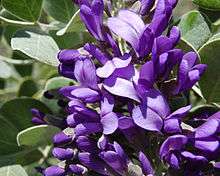Dermatophyllum
Dermatophyllum is a genus of three or four species of shrubs and small trees in the subfamily Faboideae of the pea family, Fabaceae. The genus is native to southwestern North America from western Texas to New Mexico and Arizona in the United States, and south through Chihuahua, Coahuila and Nuevo León in northern Mexico. Members of the genus are commonly known as mescalbean, mescal bean or frijolito. One of the common names of Dermatophyllum secundiflorum is Texas mountain laurel, although the name mountain laurel also refers to the very dissimilar and unrelated genus Kalmia (family Ericaceae) and the name laurel refers generally to plants in the unrelated order Laurales.
| Dermatophyllum | |
|---|---|
 | |
| Dermatophyllum secundiflorum | |
| Scientific classification | |
| Kingdom: | |
| (unranked): | |
| (unranked): | |
| (unranked): | |
| Order: | |
| Family: | |
| Subfamily: | |
| (unranked): | |
| Genus: | Dermatophyllum Scheele 1848 |
| Type species | |
| Dermatophyllum speciosum Scheele. | |
| Species | |
|
6; see text. | |
| Synonyms[2] | |
Although still commonly treated in the genus Sophora, recent genetic evidence has shown that the mescalbeans are only distantly related to the other species of Sophora.[3]
Species
Dermatophyllum comprises the following species:[2][4][5]
- Dermatophyllum arizonicum (S.Watson) Vincent—Arizona Mescalbean (Arizona, Chihuahua)
- subsp. arizonicum (S.Watson) Vincent
- subsp. formosum (Kearney & Peebles) Vincent (Arizona)
- Dermatophyllum gypsophilum (B.L. Turner & A.M. Powell) Vincent—Guadalupe Mescalbean (Southern New Mexico, western Texas, Coahuila)
- Dermatophyllum guadalupense (B.L. Turner & A.M. Powell) B.L.Turner
- Dermatophyllum juanhintonianum (B.L. Turner) B.L. Turner
- Dermatophyllum secundiflorum (Ortega) Gandhi & Reveal—Texas Mescalbean (Texas, New Mexico, Coahuila, Nuevo León)
- Dermatophyllum purpusii (Brandegee) Vincent
Description

Dermatophyllum spp. grow to 1–11 m (3.3–36.1 ft) tall, with a trunk up to 20 cm (7.9 in) in diameter, often growing in dense thickets that grow from basal shoots. The leaves are evergreen, leathery, 6–15 cm (2.4–5.9 in) long, pinnate with 5-11 oval leaflets, 2–5 centimetres (0.79–1.97 in) long and 1–3 cm (0.39–1.18 in) broad. The flowers, produced in spring, are fragrant, purple, typical pea-flower in shape, borne in erect or spreading racemes 4–10 cm (1.6–3.9 in) long. The fruit is a hard, woody seedpod 2–15 cm (0.79–5.91 in) long, containing 1-6 oval bright red seeds 1–1.5 cm (0.39–0.59 in) long and 1 cm (0.39 in) in diameter.
All parts of the mescalbeans are very poisonous, containing the alkaloid cytisine (not mescaline, as suggested by the name). Nevertheless, there is evidence of the seeds of the plant having been used in a ritualistic context as a hallucinogen by some Native American peoples.[6] The symptoms of cytisine poisoning are very unpleasant. This has led to speculation that the peyote cult may have developed as a relatively safe substitute for the potentially toxic mescalbean, given the close parallels in performance and divination between the two (including leaders of Plains Indian peyote rituals wearing a necklace of mescalbeans).[7]
References
| Wikimedia Commons has media related to Dermatophyllum. |
| Wikispecies has information related to Dermatophyllum |
- Cardoso D, Pennington RT, de Queiroz LP, Boatwright JS, Van Wyk BE, Wojciechowski MF, Lavin M (2013). "Reconstructing the deep-branching relationships of the papilionoid legumes". S Afr J Bot. 89: 58–75. doi:10.1016/j.sajb.2013.05.001.
- Gandhi KN, Vincent MA, Reveal JL (2011). "Dermatophyllum, the correct name for Calia (Fabaceae)" (PDF). Phytoneuron. 2011 (57): 1–4. ISSN 2153-733X.
- Heenan PB, Dawson MI, Wagstaff SJ (2004). "The relationship of Sophora sect. Edwardsia (Fabaceae) to Sophora tomentosa, the type species of the genus Sophora, observed from DNA sequence data and morphological characters". Bot J Linn Soc. 146 (4): 439–446. doi:10.1111/j.1095-8339.2004.00348.x.
- Turner BL. (2012). "New names in Dermatophyllum (Fabaceae)" (PDF). Phytoneuron. 2012 (3): 1–4. ISSN 2153-733X.
- "The Plant List entry for Dermatophyllum". The Plant List. Royal Botanic Gardens, Kew and the Missouri Botanical Garden. 2013. Retrieved 19 May 2014.
- James H. Howard (1957). "The Mescal Bean Cult of the Central and Southern Plains: An Ancestor of the Peyote Cult". American Anthropologist. 59 (1): 75–87. doi:10.1525/aa.1957.59.1.02a00070. JSTOR 666531.
- Robert C. Fuller (2000). Stairways To Heaven: Drugs In American Religious History. pp. 34–35. ISBN 9780813366128.